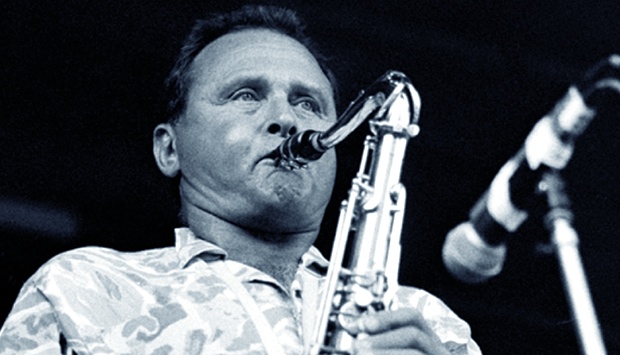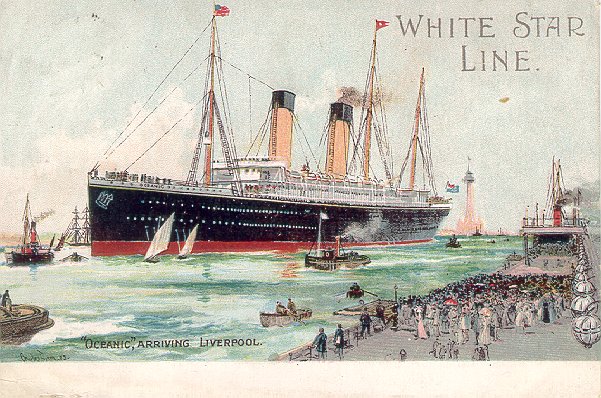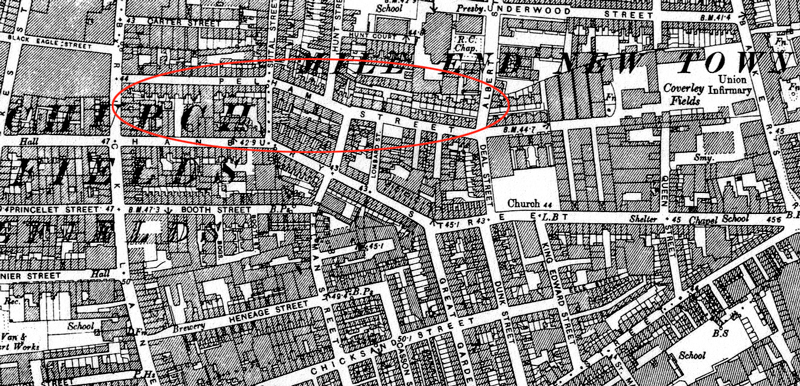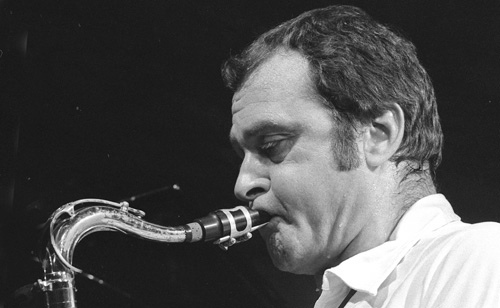Stan Getz: Delving back…
9th May 2016Join Jazz aficionado Peter Gardner as he delves back into the family history of Stan Getz, one of the very greatest Jazz Saxophonists…
When The Observer’s jazz critic Benny Green heard Stan Getz playing at Ronnie Scott’s Club in March 1971 he spoke of Getz as “one of the greatest jazz masters of all time” and he added: “It is doubtful if Getz has ever played better in his life…Getz’s genius has flowered again”.
The recordings from that period, which appeared on the Verve album ‘Dynasty’, were described by another critic as representing “an emotional peak in his (Getz’s) recorded output” (Kirkpatrick, 1992, p. 25). Finding precise reasons why musicians excel at certain times in their lives is a daunting task, but one event that affected Getz deeply at the start of 1971 was the death of his father, Al Getz, and one of the most moving performances on ‘Dynasty’ is reserved for a tune called ‘Ballad for My Dad’.

Stan Getz
Al Getz had witnessed his first born son go from being a schoolboy harmonica player – the harmonica was the only instrument the family could afford – to becoming an internationally renowned jazz saxophonist and, during the bossa-nova craze in the 1960s, he had seen Stan achieve pop-star fame, win Grammy Awards and have record sales almost unheard of for a jazz musician. Yet, in its own way, as I hope to show, Al Getz’s story is also remarkable. (1)
In 1925 in Philadelphia, Al Getz, who was working in the printing trade, married Goldie Yampolsky, the daughter of Jewish émigrés from what to-day is the Ukraine. On 2nd February, 1927, after a difficult birth in which, according to one account, forceps had nearly torn away an ear from their infant, Al and Goldie’s first child was born (Maggin, 1996, p. 2). They called him Stanley.
Delving back a little further, in 1920, when Al’s father, Harry Getz, appeared in his first census in America, we find that Harry is married to Rose, that he is a private tailor and has three sons, Al, who appears on the Census as Alex, aged 16, Pincus, aged 14, and a young child called Benjamin, aged 2 years and 3 months. It would seem that underlying this brief account of the Getz household in 1920 are some significant events: Rebecca, the mother of Alex and Pincus and Harry’s first wife, died in 1917 while giving birth to Benjamin and Harry had remarried (See op. cit., pp. 1-2). Harry has also changed his name. In a Petition for Naturalization that was completed in November 1919, Harry says his name had been Harris Giatsky and his oldest son, whom he calls Alexander in the Petition, had been born in England on 24th July, 1904, that Pincus had been born in England on 26th February, 1906, and that his youngest son, Benjamin, had been born in Philadelphia. As for himself, Harris says that he was born on 10th July, 1877, in Zitomir, Russia, which I take to be what is now called Zhitomir in Ukraine, and that he arrived in New York on 5th June, 1913, on the Oceanic, having left Southampton on 28th May, 1913.
Names dictated to officials, especially names that sound unusual to those officials, are likely to be misspelled. So, it is not surprising that we will encounter variations of Harris’ family name and his wife’s maiden name. For example, under the heading of Alien Passengers aboard the White Stars Line’s Oceanic that sailed from Southampton on 28th May, 1913, Harris is listed as Harris Gayetsky. The same document says he is a tailor, aged 36, that he is travelling with his wife, Beckie (shortened, I take it, from Rebecca), aged 32, and sons, Alex, 8, and Piny (shortened, I take it, from Pincus), 6. (2) Ellis Island Records from the completion of the family’s Atlantic crossing give Zitomir as Harris’ place of birth and say his wife was born in Elisawathgrad, which, using its English spelling, would be Elizabethgrad in present day Ukraine.

White Star Line’s Oceanic
One of our next important documents is a form for the 1911 Census for England and Wales that Harris appears to have filled in and signed himself. The writing, for example, is consistent with the signature and there is no indication that someone other than Harris was responsible for the form’s completion. If the 1911 Census form was filled in by Harris, it shows that ‘Gaietsky’ is how he spelled his family name at the time. The form says he is aged 34, his wife, Rebecca, is aged 28, they have two sons, Alec, aged 6, and Pinkus, aged 5, and they live in two rooms at 92 Romford Street, Whitechapel. The birthplace for Alec is given as “London, Whitechapel” and the birthplace of Pinkus was given as “London, Brick Lane”, but this has been crossed out and “Bethnal Green” written beneath. According to the same document Harris and Rebecca have been married seven years and they have had three children, two of whom are still living. Harris gives his occupation as “Tailor (Maker)” and under Employer, Worker, or Working on Own Account he has put “Worker”. Under Nationality for both himself and his wife he has put “Russian”.
The Schedule for the 1911 Census gives the address for Harris and his family as being 92 Fieldgate Mansions, Whitechapel. Interestingly, Fieldgate Mansions are still standing and are now the London Borough of Tower Hamlets.
When I started to make inquiries into Harris and Rebecca’s third child, who had died before the 1911 Census was completed, I found that Harris’ family name may have undergone some more changes. I discovered there was a boy called Louis Giatsky born on 29th January, 1909, to Harris, a “Tailor’s Baster”, and Rebecca Giatsky, formerly Kutlerefsky, in Whitechapel. I also discovered there was a Louis Giatsky who died aged 18 months on 30th July, 1910, of measles and bronchopneumonia at 66 Pelham Street, Whitechapel, in the presence of his father, Harris Giatsky, “a Tailor’s Baster”. (A baster, I believe, is someone who uses long tacking stitches on garments in preparation for their later sewing.)
Concerning Harris’ son who was named Pinkus in the 1911 Census, his birth certificate gives his name as Pincus Giatsky, born on 27th February, 1906 (Not 26th February as stated in Harris’ Petition for Naturalization from November 1919), to Harris, a “Tailor’s Baster”, and Rebecca Giatsky, at 66 Pelham Street, the address where Louis would die. Old maps show that Pelham Street joined the important Whitechapel thoroughfare of Brick Lane. On Pincus’ birth certificate Rebecca’s maiden name is said to be Kutlrlefsky, though some attempt has been made to indicate that the middle of the name hasn’t been spelled correctly. So, we have some supportive background to the brief items in the 1911 Census.

Pelham Street, Whitechapel
What, then of Harris and Rebecca’s eldest son, the boy named Alec Gaietsky, aged 6, in the 1911 Census and listed as Alex Gayetsky in Oceanic’s passenger list, who would lose his mother in 1917 and later become Al the husband of Goldie and the father of Stan Getz? His birth certificate shows that he was called Alexander Gaeitzky, born on 24th July, 1904 (The date stated in Harris’ Petition for Naturalization), to Harris and Rebecca Gaeitzky, who live at 140 Jubilee Street in the sub-district of Mile End Old Town West, which on old maps lies just to the east of Whitechapel. Rebecca’s former name is given as Katerofsky and at the time of Alexander’s birth Harris was said to be a “Journeyman Ladies Tailor”.
As for Jubilee Street, it survived without too many changes for a few more decades and most of it, unlike much of the East End, remained standing even after the Blitz. In fact, a 1948 map for Stepney and the Electoral Register for the same period show that 140 and many of its neighbouring terraced houses are still standing and are still well occupied. Eventually the houses in Jubilee Street, along with many other East End properties, would be demolished to make way for new developments that helped satisfy the great post-War need for social housing, though there is still a Jubilee Street in Tower Hamlets
So far we have reached 1904. Can we delve further back? Well, the 1911 Census, which says that Harris and Rebecca had been married for seven years, had to be completed in April 1911. This could mean that Harris and Rebecca married between May 1903 and April 1904, and the General Register Office for England and Wales has found a marriage certificate for Harris Gayatsky and Rebecca Katlerwsky (though the writing of Rebecca’s maiden name is far from clear) from 18th October, 1903, in the Registration District of Mile End Old Town. The marriage certificate also says that the marriage had been “solemnized” at the East London Synagogue, Mile End Old Town, and that Harris and Rebecca reside at 54, Oxford Street. But, before we start to consider life in one of London’s most famous streets and leap to conclusions about the young couple residing in splendour, we should note that there was an Oxford Street in Whitechapel in 1903 and that it had a residential property numbered 54.
We are used to tracing the roots of great jazz musicians to America’s deep and troubled south or wide-open Kansas City, but we have travelled in a very different direction. At a time of severe persecution in Russia and Eastern Europe hundreds of thousands of Jews fled westward. Many came to England. Some came to stay. Some came to earn enough for an Atlantic crossing. Some received funds from relatives already in America. Shortly after the turn of the last century a young man called Harris and a younger woman called Rebecca were part of this great movement of people. They crossed Europe, settled for a time, perhaps ten years or so, in London’s East End, where Harris found different kinds of employment in tailoring and the couple tried to raise three sons. Their eldest boy, Alexander Gaietzky, born near Whitechapel in 1904 would travel with his parents to America and Alexander’s first son would be Stan Getz, one of the greatest saxophone players in the history of jazz.
Author: Peter Gardner (April 2016)
Acknowledgements:
I am particularly grateful to Aileen Bulman, Anna Haward, Steve Marshall, Michael O’Neill, Charles Tucker and Tom Zelmanovits.
Endnotes
(1) For a fuller account of my inquiries into Stan Getz’s background and an attempt to correct some mistakes made by other writers on Getz see: Peter Gardner, ‘Stan Getz’s East End Roots’, Current Research in Jazz, 6, 2014, at
(2) It has to be admitted that there are some anomalies concerning ages for which I have no explanation. If Pincus was born in February 1906, he would have been 7 in May1913, though his age is given as 6 in the Oceanic’s list of passengers for May 1913. He would also have been 13 in January 1920 at the time the 1920 American Census was being completed, not 14 as stated in the Census. As for Alex, if he was born in July 1904, he would have been 15 when the 1920 Census was being completed, not 16 as it states.
References
Green, B., The Observer, 14th March, 1971.
Kirkpatrick, R. (1992) Stan Getz: An Appreciation of His Recorded Work (Zany Publications, Bath).
Maggin, D. L. (1996) Stan Getz: A Life in Jazz (William Morrow, New York).
